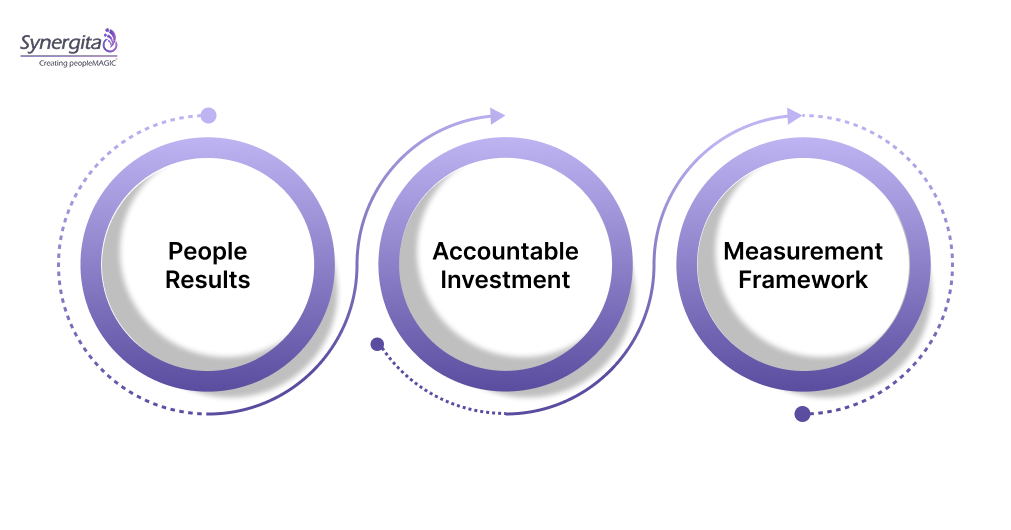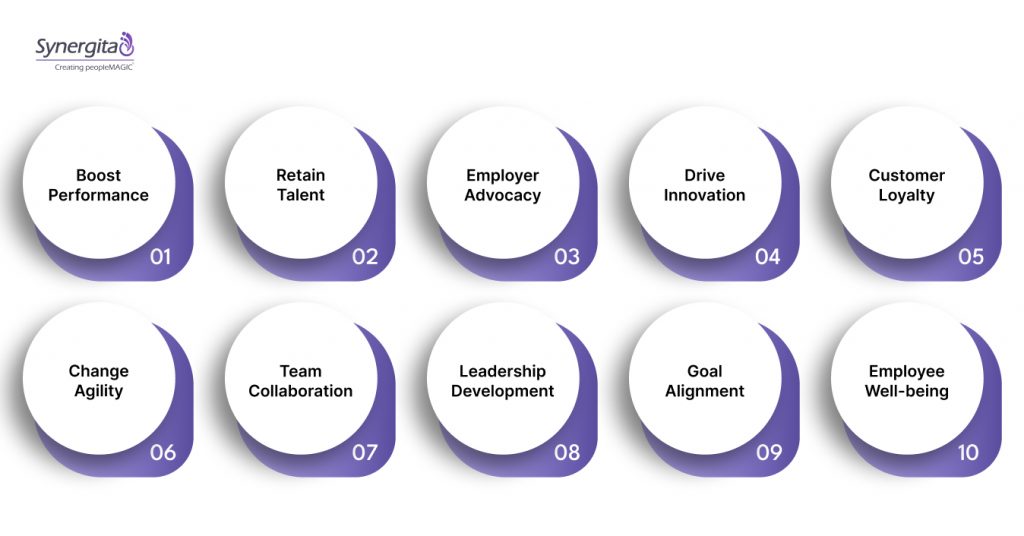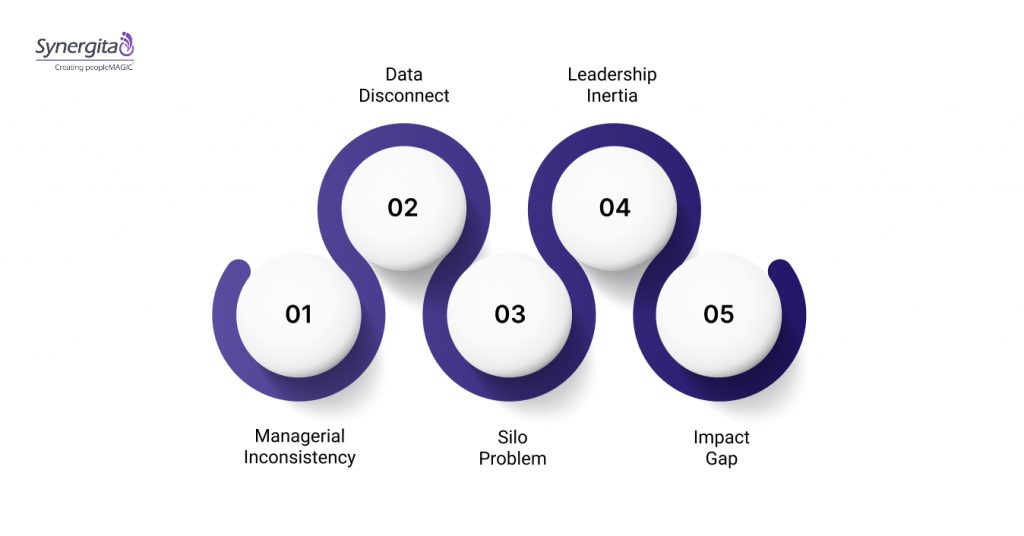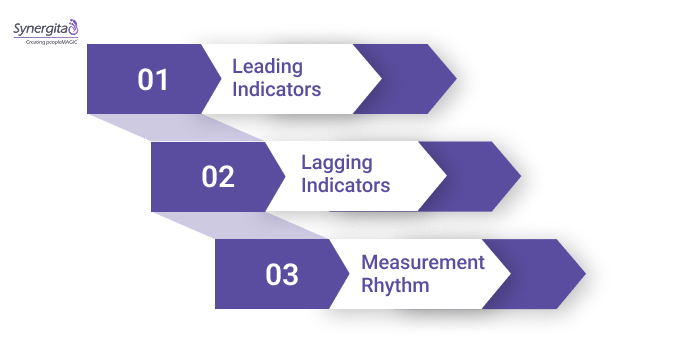Your employee engagement survey results are in. The scores are stable, yet your top talent is leaving, productivity is inconsistent, and your customer satisfaction metrics are stagnant. This is the engagement paradox: measuring sentiment without achieving business outcomes.
With disengaged employees costing the global economy an estimated $2 trillion in lost productivity, the leadership crisis is no longer abstract; it’s a tangible drain on your bottom line.
The problem is not a lack of effort, but a misalignment of purpose. When engagement is treated as a standalone HR activity, a series of surveys and events, it fails to connect to the core drivers of your business performance. You are tracking a number, not building a strategic asset.
This guide moves beyond the metrics to define the core objectives of employee engagement. We will outline the challenges, tools, and techniques and provide a clear framework for achieving them.
Key Takeaways
- From Measurement to Impact: Define engagement by the business outcomes it drives, not just the survey scores it generates.
- Alignment as Foundation: Ensure every employee’s work directly connects to organizational priorities for unified execution.
- Managers as Multipliers: Equip front-line leaders with consistent tools and clear accountability for team engagement.
- Integration Over Initiatives: Embed engagement into daily workflows rather than creating separate, siloed programs.
- Outcomes Over Activity: Track business metrics like retention and performance to validate your engagement strategy.
- Systematic Execution: Connect listening, development, and goals in one platform to close the gap between insight and action.
What is employee engagement?
Employee engagement is the level of commitment, passion, and investment an employee has in their work and organization. It is not synonymous with satisfaction or happiness. A satisfied employee may be content with their job, but an engaged employee is psychologically invested in contributing to the company’s success.
They provide discretionary effort, demonstrate ownership, and act as an advocate for the business. This state is the outcome of a systematic, supportive work environment. It results from clear communication, meaningful work, regular recognition, opportunities for growth, and a sense of genuine connection to the company’s mission and leadership.
Engagement is the mechanism that converts human potential into tangible business results.
This distinction between satisfaction and strategic investment is critical, but it only matters if it’s directed toward a specific business purpose. Let’s learn why it is important.
Why Are Employee Engagement Objectives Important For An Organization?

Without defined objectives, employee engagement remains a vague concept that fails to justify its place in your business strategy. Clear objectives convert engagement from an abstract HR metric into a driver of specific, measurable outcomes.
Here’s why it is important:
1. Connecting People Programs to Business Results
Objectives force you to answer the “so what?” for every initiative. Instead of “improving survey scores,” your objective becomes “reducing voluntary turnover in high-impact roles by 15%.” This shifts the focus from activity to outcome, ensuring your programs directly affect revenue protection, productivity, and customer satisfaction.
2. Creating Accountability and Focus Investment
When you define what you aim to achieve, you can assign ownership and allocate resources effectively. Objectives like “increase internal promotion rates by 20%” or “improve cross-departmental collaboration scores” provide a clear benchmark for success.
This prevents the scattergun approach of running multiple, uncoordinated programs and allows you to concentrate efforts on what matters most to your strategic goals.
3. Providing a Framework for Measurement
Objectives move you beyond annual pulse surveys. They demand a system of continuous measurement against key performance indicators. By linking engagement efforts to objectives like “decrease time-to-productivity for new hires” or “improve safety compliance rates,” you gain concrete data to demonstrate ROI and guide future strategy.
Also read: How to Make Better Strategic Decisions in 2025: Process, Tools & Examples
With this strategic foundation established, we can define the specific business outcomes a mature engagement strategy must deliver.
Core Objectives of Employee Engagement

Understanding engagement is one thing; directing it toward specific business outcomes is another. Without clearly defined objectives, your engagement efforts remain a collection of well-intentioned activities with no measurable return.
The following objectives are not a checklist of HR tasks. They are a set of strategic business results that a mature engagement strategy delivers. Each one connects directly to a critical performance metric you already track, from productivity and retention to innovation and customer satisfaction.
Use this list to align your people strategy with your business priorities and move from measuring sentiment to managing a strategic asset.
1. Drive Higher Productivity and Performance
This objective focuses on converting engagement into measurable output and quality. Engaged employees apply discretionary effort, leading to greater efficiency and innovation.
How it looks when achieved successfully:
- Teams consistently exceed performance targets with less supervision.
- There is a visible increase in process improvements and innovative solutions.
- Quality metrics show sustained improvement with fewer errors and rework.
2. Retain Top Talent and Critical Skills
This aims to reduce voluntary turnover, particularly among high performers, by creating an environment where people choose to stay. It directly protects your institutional knowledge and recruitment budget.
How it looks when achieved successfully:
- Voluntary turnover rates, especially in key roles, show a measurable decline.
- Exit interview data consistently cite positive culture and growth as reasons for staying.
- Internal promotion and lateral move rates increase.
3. Strengthen Employer Brand and Advocacy
Transform employees into voluntary promoters of your organization. This objective turns your workforce into your most credible recruitment and marketing asset.
How it looks when achieved successfully:
- Employee Net Promoter Score (eNPS) shows a strong positive trend.
- Employees actively refer qualified candidates and defend the company publicly.
- Social media channels see organic, positive employee-generated content.
4. Foster a Culture of Innovation
Create conditions where employees feel psychologically safe to experiment, challenge norms, and propose new ideas without fear of failure.
How it looks when achieved successfully:
- A measurable percentage of revenue comes from employee-suggested innovations.
- Cross-functional teams self-organize to solve complex problems.
- Leadership regularly implements and credits employee-led improvements.
5. Enhance Customer Satisfaction and Loyalty
This objective recognizes that engaged employees create better customer experiences. It directly links internal culture to external commercial outcomes.
How it looks when achieved successfully:
- Customer satisfaction (CSAT) and Net Promoter Score (NPS) metrics improve.
- Customer feedback specifically praises employee expertise and service.
- Customer retention rates increase in frontline and service teams.
Also read: Are You Tracking the Right Metrics for Employee Retention in 2025?
6. Build Organizational Agility and Change Resilience
Prepare your workforce to adapt quickly to market shifts and internal transformations. This objective focuses on maintaining productivity during disruption.
How it looks when achieved successfully:
- Major change initiatives meet implementation timelines with less resistance.
- Employees proactively update skills to meet evolving business needs.
- Engagement scores remain stable during periods of significant change.
7. Improve Cross-Functional Collaboration
Break down departmental silos by creating shared purpose and trust across the organization. This objective targets the efficiency lost to internal friction.
How it looks when achieved successfully:
- Project completion times decrease due to smoother inter-department cooperation.
- Leaders report less time spent resolving internal conflicts.
- Employees regularly seek input and expertise from other departments.
8. Develop Future Leaders from Within
Create a reliable pipeline of leadership talent by systematically identifying and preparing high-potential employees for greater responsibility.
How it looks when achieved successfully:
- Over 70% of leadership positions are filled through internal promotions.
- Succession plans for critical roles have multiple qualified internal candidates.
- High-potential employees show longer tenure and greater loyalty.
9. Ensure Strategic Goal Alignment
This objective ensures every employee understands how their work contributes to organizational priorities, creating unified direction and purpose.
How it looks when achieved successfully:
- Employees at all levels can articulate how their goals support company objectives.
- There is consistent progress on key organizational OKRs and initiatives.
- Departmental priorities show a clear connection to the overall business strategy.
10. Promote Employee Well-being and Sustainable Performance
Create an environment where employees can perform at their best without sacrificing their health or personal life. This objective addresses the root causes of burnout.
How it looks when achieved successfully:
- Voluntary attrition due to stress or burnout shows a measurable decrease.
- Utilization of paid time off becomes more consistent and distributed.
- Health insurance claims related to stress show a declining trend.
Ready to convert these objectives into your company’s success story? Book a demo to map the Synergita platform directly to your top engagement priorities.
Also read: How to Develop an Effective HR Strategy Framework
These objectives define the destination, but the path is obstructed by systemic organizational barriers you must anticipate.
Challenges In Achieving Engagement Objectives

Defining objectives is straightforward; achieving them requires confronting deeply embedded organizational obstacles. These are not superficial issues of program design, but fundamental structural and cultural barriers that undermine even well-funded initiatives.
Recognizing these challenges is the first step toward building an engagement strategy that delivers lasting impact. Here are the primary challenges that prevent organizations from realizing their engagement objectives.
1. Inconsistent Managerial Execution
Your engagement strategy is only as effective as your least-effective manager. Even with clear objectives, inconsistent application by front-line managers creates engagement dead zones. Manager capability gaps become organizational risk points.
Solution: Implement mandatory, standardized training for people managers focused on practical skills: conducting career development conversations, providing constructive feedback, and recognizing employee contributions. Tie manager compensation and advancement directly to their team’s engagement and retention metrics.
2. Disconnected Data and Action
Many organizations collect engagement data but lack the analytical capability to convert it into targeted interventions. Survey results become a reporting exercise rather than a diagnostic tool, creating a cycle of measurement without improvement.
Solution: Move beyond annual surveys to a system of continuous listening and closed-loop feedback. Use pulse surveys and AI-powered sentiment analysis to identify issues in real-time. Require each department leader to create and execute specific action plans based on their team’s data.
3. The Siloed Initiative Problem
When engagement is owned solely by HR, it becomes disconnected from core business operations. Standalone programs, a recognition platform here, a wellness app there, fail to create a cohesive employee experience and compete for attention.
Solution: Integrate engagement directly into existing business workflows. Embed goal-setting within performance management, incorporate recognition into project management tools, and discuss development in regular team meetings. Make engagement a byproduct of work, not an addition to it.
4. Leadership Inertia and Superficial Support
Executive teams often endorse engagement in principle while maintaining leadership behaviors and operational rhythms that directly undermine it. A mandate for agility paired with quarterly business reviews that punish risk-taking creates clear dissonance.
Solution: Hold leadership accountable for modeling the behaviors that drive engagement. Include 360-degree feedback on people leadership in executive scorecards. Redesign key business processes, like budgeting and strategic planning, to support the agility and transparency you claim to value.
5. The Measurement-Impact Gap
Organizations frequently measure engagement activity rather than business impact. Tracking participation in programs tells you nothing about whether those programs are achieving strategic objectives like retention or productivity gains.
Solution: Redefine your success metrics to focus on outcomes, not activities. Instead of measuring training attendance, track the application of new skills. Correlate engagement efforts with business-unit performance data to identify which interventions actually drive results.
Identifying these barriers is futile without the proper systems to dismantle them and systematically build engagement.
Tools And Techniques To Support Engagement Objectives
To achieve the strategic objectives we’ve outlined, you need specific tools and methodologies that integrate directly into your workflow. These are not standalone perks, but systematic approaches that create the conditions for sustained engagement.
1. Continuous Listening Platforms
Move beyond the annual survey with tools that provide real-time insight into employee sentiment. Pulse surveys, always-on feedback channels, and AI-powered sentiment analysis allow you to identify issues as they emerge rather than months later.
Application: Deploy short, weekly pulse surveys on specific topics like workload or collaboration. Use natural language processing to analyze feedback from exit interviews and manager check-ins for recurring themes.
2. Integrated Performance-Development Systems
Connect engagement directly to growth by merging performance management with career development. Platforms that support continuous feedback, goal alignment, and skill tracking make development a daily activity rather than an annual event.
Application: Implement a system where quarterly goal-setting is directly linked to skill development plans. Use 360-degree feedback to create targeted coaching moments rather than just annual reviews.
3. Structured Career Pathing Tools
Make internal mobility operational rather than aspirational. Tools that visualize career lattices, identify skill gaps for target roles, and match employees with internal opportunities create tangible paths for growth.
Application: Deploy an internal talent marketplace that connects employees to project-based work and full-time roles. Use skills taxonomy tools to show clear pathways from current roles to future positions.
4. Workflow Integration Techniques
The most effective engagement tools are those that employees use naturally in their daily work. Embed recognition, feedback, and goal-tracking directly into project management software, communication platforms, and existing business systems.
Application: Integrate peer recognition into your primary communication platform. Embed pulse survey questions into project completion workflows. Make goal progress visible in the tools teams already use daily.
Equipped with the right tools, your focus must shift to a disciplined measurement framework that proves its impact.
How To Measure If Your Employee Engagement Goals Are Being Met?

Measuring engagement requires moving beyond annual survey scores to a system of interconnected business metrics. You need to track both the direct indicators of employee sentiment and the business outcomes that sentiment drives.
Below is a detailed explanation:
Leading Indicators: Measuring Sentiment and Experience
These metrics provide early signals of engagement levels and help you identify issues before they impact performance.
- eNPS (Employee Net Promoter Score): Track the answer to “How likely are you to recommend this company as a great place to work?” A rising score indicates growing advocacy.
- Feedback Frequency and Sentiment: Monitor the volume and tone of unsolicited feedback through pulse surveys and platform analysis. Increased, positive communication signals psychological safety.
- Recognition and Collaboration Data: Analyze participation rates in peer recognition programs and cross-departmental project work. High levels of organic recognition and collaboration reflect strong connections.
Lagging Indicators: Quantifying Business Impact
These outcomes demonstrate the tangible return on your engagement investment.
- Retention and Internal Mobility Rates: Calculate voluntary turnover, particularly for high performers. Track the percentage of open roles filled internally. Improvement here directly validates your engagement strategy.
- Performance and Productivity Metrics: Correlate engagement data with team-level performance against goals (OKRs), project completion rates, and quality metrics. Engaged teams show consistent, high-quality output.
- Customer-Facing Metrics: Analyze the relationship between team engagement scores and corresponding customer satisfaction (CSAT) and Net Promoter Scores (NPS). This proves the connection between internal culture and external results.
Establishing a Measurement Rhythm
Data without a consistent review cycle is useless. Implement a cadence that creates accountability.
- Quarterly: Review pulse survey results, eNPS, and recognition data with department leaders.
- Semi-Annually: Conduct deeper analysis correlating engagement metrics with performance and retention data.
- Annually: Run a comprehensive benchmark survey to track long-term trends and validate your ongoing strategy.
Also read: How to Improve Employee Performance: Effective Strategies
Measurement reveals the gap between insight and improvement, a gap that cannot be closed with fragmented point solutions.
Make Engagement Actionable With Synergita
The gap between measuring engagement and improving it remains the primary point of failure for most organizations. Data alone cannot close this gap; it requires a system that integrates insight directly into managerial action and strategic planning. Without this, survey results become a historical report rather than a blueprint for progress.
Synergita bridges this gap by connecting continuous listening with performance enablement and career development in a single platform. This integration ensures that engagement data directly informs managerial conversations, strategic goal-setting, and individual growth plans, creating a closed-loop system for building a high-commitment workforce.
The platform addresses this through specific, connected capabilities:
- Convert Sentiment into Strategy: Use AI-powered sentiment analysis on feedback and survey data to identify underlying drivers of engagement and disengagement, moving beyond surface-level scores to actionable insights.
- Close the Feedback Loop Systematically: Embed pulse surveys and recognition directly into workflows, and automatically prompt managers with tailored discussion guides for their team check-ins based on real-time results.
- Align Engagement with Growth and Performance: Connect engagement data directly to individual development plans and goal-setting within the performance management module, ensuring career growth conversations are informed by team morale and engagement trends.
- Track Impact with Integrated Analytics: Correlate engagement metrics with business outcomes like team performance on OKRs, retention rates, and internal mobility within a unified analytics dashboard.
This approach transforms employee engagement from an abstract measurement into a manageable, strategic business process.
Conclusion
The strategic objectives of employee engagement, from driving productivity and innovation to securing your talent pipeline, are non-negotiable for organizational resilience. Achieving them requires moving beyond periodic surveys to a system that integrates continuous listening, meaningful development, and clear goal alignment into the daily workflow.
This transforms engagement from an HR metric into a core business driver. A unified platform is essential to connect these elements. Synergita provides the necessary infrastructure to close the gap between insight and action, linking engagement data directly to performance management, career pathing, and recognition in a single, coherent system.
Book a demo to see how a unified approach can systematically achieve your specific engagement objectives.
FAQs
Q. What’s the difference between employee satisfaction and engagement?
Satisfaction indicates basic contentment with job conditions like pay and benefits. Engagement represents psychological investment where employees contribute discretionary effort, show ownership, and act as brand advocates. Satisfaction is the foundation; engagement is the strategic outcome that drives business results.
Q. How many employee engagement objectives should we focus on at once?
Prioritize 3-5 core objectives aligned with your most pressing business needs. Focusing on too many objectives dilutes resources and impact. Start with foundational goals like retention and goal alignment before expanding to innovation and employer branding.
Q. What are the most important metrics for tracking engagement objectives?
Combine leading indicators (eNPS, feedback sentiment, recognition rates) with lagging business outcomes (retention of high performers, internal mobility rates, customer satisfaction scores). This approach connects employee sentiment directly to business impact.
Q. How do we get managers to take ownership of engagement objectives?
Tie manager compensation and advancement directly to their team’s engagement metrics and retention rates. Provide them with specific action plans based on team feedback and equip them with standardized tools for career development conversations and recognition.
Q. Can we achieve engagement objectives in a remote/hybrid work environment?
Yes, but it requires intentional design. Focus on objectives that translate effectively to distributed teams: clear goal alignment through OKRs, systematic recognition through digital platforms, structured career pathing, and measuring output rather than presence.



